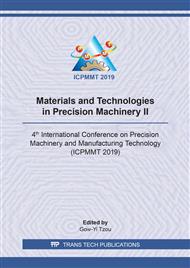p.1
p.9
p.15
p.29
p.37
p.43
p.53
p.59
FEM Simulation of Multi-Stage Forging for Dray Fasteners
Abstract:
This study uses the dies of the dray fasteners processing graphics provided by the fastener’s industry to establish 3D dies and components solid models based on the embedded drawing function tools provided by the component model (Standard.ipt) of Autodesk Inventor CAD software. After finishing the dies and components drawing, the integrated assembly drawing of dies can be obtained through the assembly model (Standard.iam) firstly. Three stages forming processes can be conducted and carried out the FEM simulation to check the forming acceptance. The effective stress, the effective strain, the velocity field, and the forging force can be obtained by the FEM simulation. Moreover, the realistic experiment can be performed to verify the acceptance of FEM simulation. The dimensions of final product can be measured to get the errors between FEM and experiment. It is noted that the errors show a good agreement with the experiment.
Info:
Periodical:
Pages:
1-8
Citation:
Online since:
February 2020
Authors:
Keywords:
Price:
Сopyright:
© 2020 Trans Tech Publications Ltd. All Rights Reserved
Share:
Citation:


